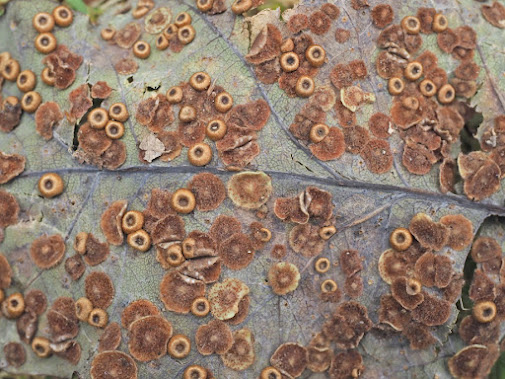The weather forecast for the first walk of the winter programme was not
very promising but, after an initial heavy squall, the morning was one of sunny
intervals, occasional showers and (sometimes double) rainbows. It was about one
hour before a very high tide and, to keep the prevailing SW wind at our backs,
we followed an anti-clockwise route around Normandy Marsh.
 |
Dunlin and Ringed Plover roosting at Normandy Lagoon during high tide
© Chris Robinson |
Hampshire County Council began purchasing the coastal grazing marshes
between Lymington and Keyhaven in 1973 with the acquisition of Normandy Farm. Normandy
Farm Lagoon is a product of the seawall reconstruction (1990-94), itself
constructed with perforated concrete blocks to aid re-vegetation.The farmland
provided fill for the wall and the lagoon was created when the land was flooded
with salt-water in early November 1990.
The current wind direction does not favour bird migration: In the departure
lounge, Swallows and Wheatear. Recent arrivals, Wigeon and Teal.
 |
Wheatear stooped off on its autumn migration
© Chris Robinson |
 |
Wigeon newly arrived for the winter from the North
© Chris Robinson |
|
Amongst a number of Little Egrets, "JN" (the oldest known Little
Egret in Britain) still commanded his regular spot. Any hope of seeing Snipe
was dashed by the presence of large numbers of Canada Geese. These "noisy
neighbours" would not be appreciated by a bird that likes to keep to
cover. |
Other sightings included: female Shoveler, Little Grebe, Cormorant,
Oystercatcher, Ringed Plover, Grey Plover, Lapwing, Dunlin, Turnstone, Curlew,
Redshank, Green- shank, Black-headed Gull, juvenile Herring Gull, Kingfisher:
Pied Wagtail, Meadow Pipit, Chiffchaff, Starling and Linnet. The non-birding highlight was a Fox Moth caterpillar probably heading for somewhere to pupate.
 |
| Fox Moth caterpillar © Chris Robinson |
Returning along Normandy Lane there were two groups of Roe Deer in the
fields: a doe with fawn in one and two does, a buck and a fawn in another.
In just over 2 hours we were back at Maiden Lane, and reasonably dry!
Please note: Our regular winter bird
walks that used to take place on the first Sunday of the month (October-March)
in the past have been moved to the first Monday of the month.























